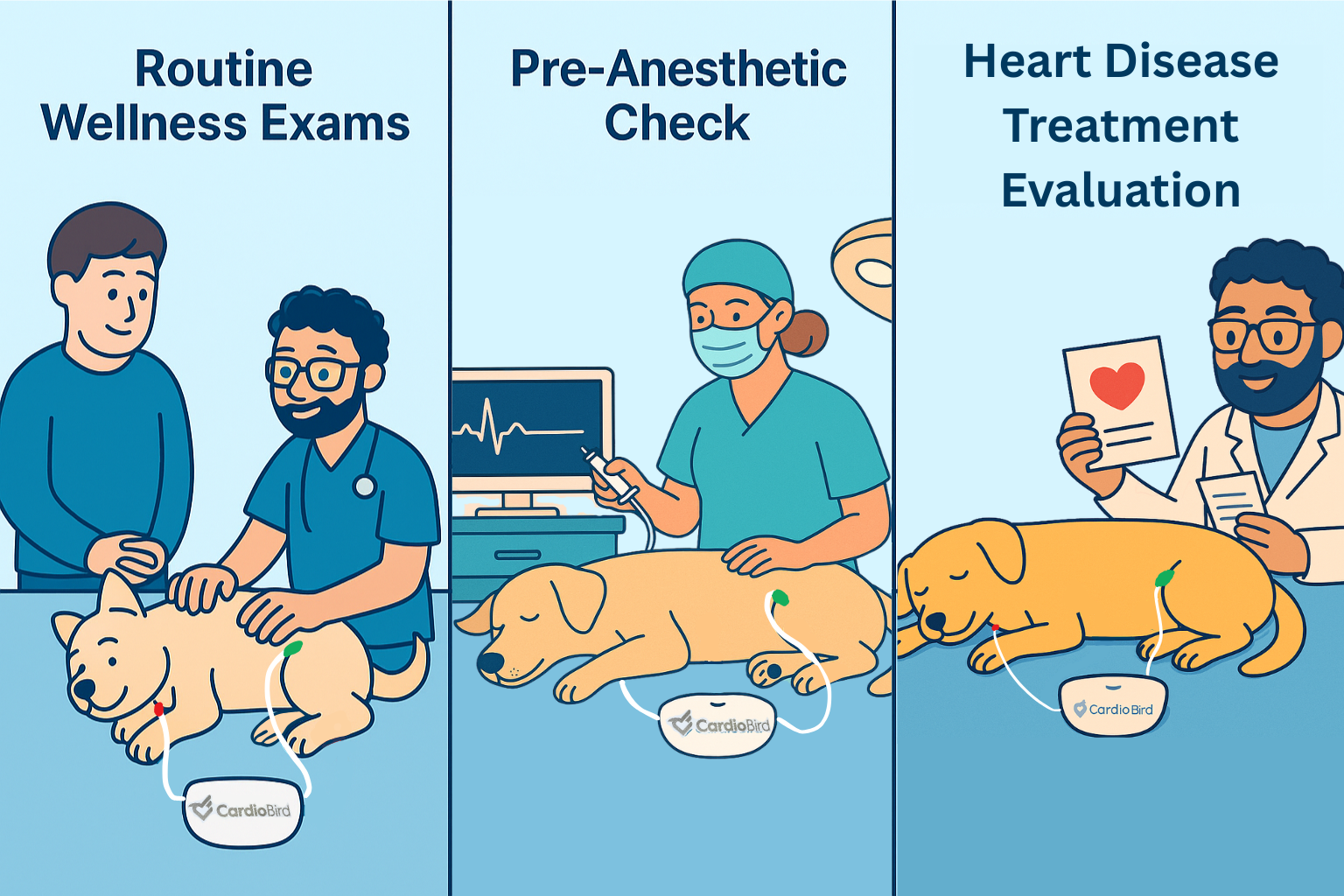CardioBird Playbook: Seamlessly Integrating AI-ECG into Your Daily Veterinary Practice

Estimated reading time: 6.31 minutes
Welcome to the CardioBird family!
As a new user of our AI-powered ECG service platform, or any veterinary clinic looking to elevate your cardiac care, this playbook provides a practical guide to seamlessly integrate ECGs into your daily workflow. Early detection and proactive management of cardiac conditions can significantly improve patient outcomes, and CardioBird is here to make that simpler and more efficient.
This guide will walk you through key integration points, highlight the evidence-based value of ECGs, offer communication strategies for pet owners, and suggest ways to empower your entire team.
Why Integrate ECGs? The Silent Language of the Heart
Electrocardiography (ECG) is a non-invasive, invaluable diagnostic tool that provides a window into the electrical activity of the heart. It can detect arrhythmias (irregular heartbeats), conduction disturbances, and provide insights into cardiac chamber enlargement. Many cardiac conditions in pets can be silent in their early stages, making routine ECG screening a cornerstone of proactive care. Integrating ECGs allows for earlier diagnosis, more tailored treatment plans, and ultimately, improved longevity and quality of life for your patients.
Key Integration Points for CardioBird ECG:
Here’s how you can effectively incorporate CardioBird ECG into your practice:
1. Routine Wellness Exams: Proactive Screening for a Healthier Future
- Why Integrate ECG?
- Early Detection: Many pets, especially certain breeds predisposed to heart disease (e.g., Cavalier King Charles Spaniels, Doberman Pinschers, Maine Coons), may not show overt clinical signs until the disease is advanced. An estimated 3 out of 5 aged dogs and 1 in 6 seemingly healthy cats might have heart disease. Routine ECGs can pick up subtle electrical abnormalities indicative of underlying issues long before they become clinically apparent.
- Baseline Establishment: An ECG taken when a pet is healthy provides a valuable baseline. Future ECGs can then be compared to this baseline, making it easier to identify significant changes over time.
- Increased Diagnostic Yield: Adding an ECG to your standard wellness protocol enhances the comprehensiveness of your preventative care services.
- How to Integrate:
- Incorporate a CardioBird ECG as part of your annual or bi-annual wellness examination, especially for middle-aged to senior pets or predisposed breeds.
- The easy operation of CardioBird makes the process quick (often under a minute) and minimally stressful for the patient.
- Communicating with Pet Owners:
- “As part of [Pet’s Name]’s comprehensive wellness check today, we recommend performing an ECG, which is a quick and painless heart screening. Just like in human medicine, this helps us detect any hidden heart rhythm issues early on, even before they show symptoms. This allows us to establish a baseline for their heart health and intervene early if needed, ensuring they stay active and healthy for longer.”
- “As part of [Pet’s Name]’s comprehensive wellness check today, we recommend performing an ECG, which is a quick and painless heart screening. Just like in human medicine, this helps us detect any hidden heart rhythm issues early on, even before they show symptoms. This allows us to establish a baseline for their heart health and intervene early if needed, ensuring they stay active and healthy for longer.”
2. Pre-Anaesthetic Checks: Ensuring Safer Sedation and Surgery
- Why Integrate ECG?
- Risk Assessment: Anesthesia, while routine, always carries a degree of cardiovascular risk. Cardiovascular complications are a leading cause of anesthetic-related deaths in dogs and cats, reportedly accounting for up to 74% of such incidents. An ECG helps identify pre-existing cardiac abnormalities that might increase anaesthetic risk, such as undetected arrhythmias.
- Tailoring Anaesthetic Protocols: Findings from a pre-anaesthetic ECG can guide your choice of anaesthetic agents and monitoring strategies, leading to safer procedures. This aligns with the American Animal Hospital Association (AAHA) Anesthesia and Monitoring Guidelines for dogs and cats, which recommend preanesthetic ECGs.
- Peace of Mind: Knowing the patient’s cardiac status pre-operatively provides peace of mind for both the veterinary team and the pet owner.
- How to Integrate:
- Make a CardioBird ECG a standard component of your pre-anaesthetic workup for all patients, regardless of age or perceived health status.
- Perform the ECG during the pre-operative consultation or on the day of the procedure before premedication.
- Communicating with Pet Owners:
- “Before [Pet’s Name] undergoes anaesthesia for their procedure, we strongly recommend an ECG. This is a safety measure to check their heart’s electrical activity and rhythm. It helps us identify any underlying conditions that could pose a risk during anaesthesia and allows us to tailor the safest possible anaesthetic plan for them. It’s a simple step that significantly enhances the safety of the procedure.”
3. Heart Disease Treatment Evaluation: Monitoring Progress and Optimising Care
- Why Integrate ECG?
- Monitoring Efficacy: For patients diagnosed with heart disease and on medication (e.g., anti-arrhythmics, diuretics, ACE inhibitors), regular ECGs are crucial for monitoring the effectiveness of the treatment in controlling arrhythmias or managing heart rate.
- Detecting Drug Side Effects: Some cardiac medications can have proarrhythmic effects or alter electrolyte balances, which can be reflected in ECG changes.
- Guiding Adjustments: ECG findings help you make informed decisions about adjusting medication dosages or types to optimize therapeutic outcomes.
- How to Integrate:
- Schedule follow-up CardioBird ECGs at regular intervals (e.g., weekly, monthly, or quarterly) for patients on cardiac medications, as dictated by the specific condition and treatment plan.
- Perform an ECG if a patient on cardiac medication presents with new or worsening clinical signs (e.g., lethargy, syncope, exercise intolerance).
- Communicating with Pet Owners:
- “Now that [Pet’s Name] is on medication for their heart condition, regular ECG check-ups are important. These quick tests allow us to see how well the medication is working to control their heart rhythm and ensure the dose is optimal. It also helps us catch any potential side effects early. This proactive monitoring is key to managing their condition effectively and maintaining their quality of life.”
4. Other Suitable Areas for ECG Integration:
- Geriatric Patients: Older pets are at higher risk for developing cardiac disease.
- Symptomatic Patients: Pets presenting with signs such as syncope (fainting), weakness, exercise intolerance, coughing, or unexplained lethargy.
- Breed Predispositions: Screening breeds known for inherited heart conditions at recommended ages.
- Murmur Workup: While echocardiography is the gold standard for diagnosing structural heart disease, an ECG can provide complementary information on rhythm disturbances that may accompany a murmur.
Streamlining Workflow: Empowering Your Veterinary Team
To successfully integrate ECGs without overburdening veterinarians, delegation is key, mirroring practices in human healthcare. Veterinary assistants, nurses, or technicians are perfectly capable of performing routine CardioBird ECGs.
- Training: Ensure your technical staff are trained on proper patient positioning, lead placement (even for a single lead, consistency is important for AI interpretation), and operating the CardioBird device. CardioBird’s user-friendly interface simplifies this process.
- Standard Operating Procedures (SOPs): Develop clear SOPs for when and how ECGs should be performed by technicians. This includes patient preparation, data entry, and how to flag abnormal findings for veterinarian review.
- Veterinarian’s Role: The veterinarian’s primary role becomes interpreting the AI-assisted findings (especially those flagged as abnormal or equivocal), integrating them with other clinical information, making diagnostic decisions, and communicating with pet owners.
- Benefits of Delegation:
- Efficiency: Frees up veterinarians’ time to focus on diagnosis, treatment planning, and complex cases.
- Increased Throughput: Allows for more ECGs to be performed daily.
- Team Empowerment: Provides professional growth opportunities for support staff and fosters a collaborative team environment.
- Cost-Effectiveness: Optimises the use of your team’s skills.
- Implementing this delegation strategy:
- Identify Lead Technician(s): Designate specific technicians to champion the ECG integration and train others.
- Hands-on Training: Utilize CardioBird’s training resources and conduct in-house practice sessions.
- Integrate into Workflow Software: If possible, add ECGs as a selectable service in your practice management software, assignable to technicians.
- Regular Review: Periodically review the ECG workflow with your team to identify any bottlenecks or areas for improvement.
Conclusion: Elevate Your Cardiac Care with CardioBird
Integrating CardioBird’s AI-ECG into your daily practice is a strategic move towards providing superior, proactive cardiac care. By leveraging this technology in wellness exams, pre-anaesthetic checks, and ongoing disease management, you can detect heart conditions earlier, manage them more effectively, and enhance patient safety. Empowering your skilled veterinary technicians to perform the ECGs streamlines your workflow, making this advanced diagnostic accessible for more patients.
CardioBird is more than just a device; it’s a partner in elevating your standard of care. We are confident that by implementing these practical steps, you will quickly see the profound benefits for your patients, your clients, and your practice.


